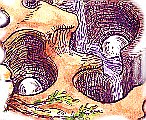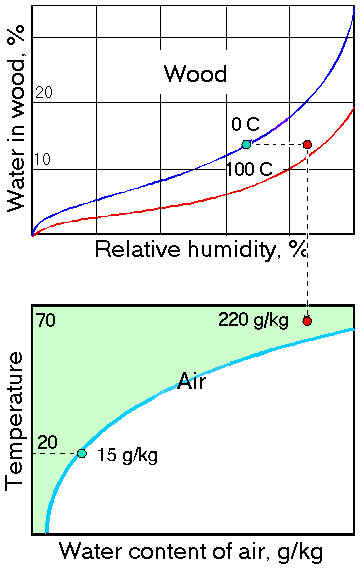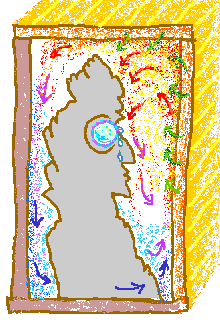
 |
A Himalayan Legend - 3 |
Suppose that the box was made well in advance from wood equilibrated with the air of the mountain temple. At an average temperature of about -2 degrees and an average RH of at least 65% wood will equilibrate to a moisture content of about 14%.

In these high Himalayan valleys a peculiar microclimate prevails, described by Sanders in his memoirs of orchid hunting in the region, at about the same time as Froschfeld was collecting his stories. The mountain tops are nearly always in the clouds but the valleys are so deep that as the air moves down into them it warms up and the clouds evaporate, giving reliable sunshine every day during certain seasons of the year, which are those chosen for tribal gatherings. The air is thin, however, and so the solar radiation is intense.
A box painted with sombre archaic symbols in charcoal and earth colours would heat up by absorbing this radiation, particularly if an oily binder was used for the paint, sealing the surface and preventing cooling by evaporation of water from the wood. The surface could easily reach 90 degrees. The inside surface would be uncoated. Evaporation of water to the inside of the container would be unimpeded. The inner surface would therefore not be so warm, maybe 70 degrees. At this temperature wood with a moisture content of 14% is in equilibrium with air of about 86% RH.
The upper diagram shows the response of wood to this temperature change. The change in equilibrium RH is about 20 percent. The change in moisture content of the air in contact with the wood is, however, much more dramatic. Water would have diffused out of the wood to maintain the RH in the warm air close to the surface of the wood at 86%. The lower diagram plots the warm air on the Mollier diagram. The red spot corresponds to 70 degrees, and 85%RH. The water content is 220 g/kg.

This is a water content vastly above the saturation concentration at the surface of the silver eye, which we can guess would have warmed up to say 20 degrees. The saturation water vapour content for air at the surface of the silver is about 15 g/kg. A colossal amount of water is therefore available in the air at the wood surface, waiting to condense on the surface of the silver as the air convects strongly in the case, which was no doubt oriented carefully to encourage thermal circulation. As condensation on the silver removes water from the air, the wood, as a good buffer should, replenishes the supply. The process would continue for a long time because silver has a fairly high heat capacity and very good heat conductivity, so it would warm up slowly, mainly by absorption of the heat of condensation of the water. The wood of the cool side of the case would also absorb water but we must assume that Sedemichra prevented this by waxing the surfaces that would be on the shady side. I speculate on the possibility that he timed the decision to end the dance by glancing through a small hole in the case, through which he could observe the process by the light from another small hole oriented to cast a narrow sunbeam on the eye. Silver reflects solar radiation well, so there would be no danger of direct solar heating. However, one must guard against unnecessary speculation about what happened so long ago.
It is evident from this tale that the important thing to take care of in packaging a work of art is the thermal insulation rather than the humidity buffering. We must admire the wisdom of Sedemichra, who showed a knowledge of the moisture absorbing properties of wood and air which allowed him to save his people. But what should we think of an act that jeopardised the stability of a holy relic? Nowadays he would surely have been called before the ethics committee.
This story is adapted from an article published in the ICCM Bulletin (Australia) vol.13 pp43-55 (1987). Copyright Tim Padfield

This work is licensed under a Creative Commons Attribution-Noncommercial-No Derivative Works 3.0 License.